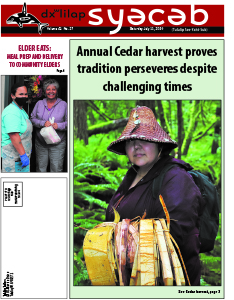Please use the following link to download the July 18, 2020 issue of the syəcəb
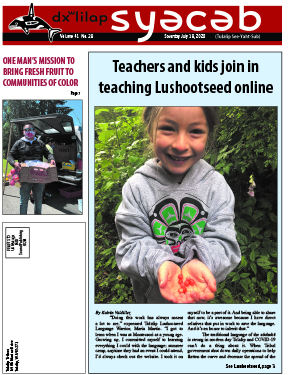
syəcəb
Please use the following link to download the July 18, 2020 issue of the syəcəb

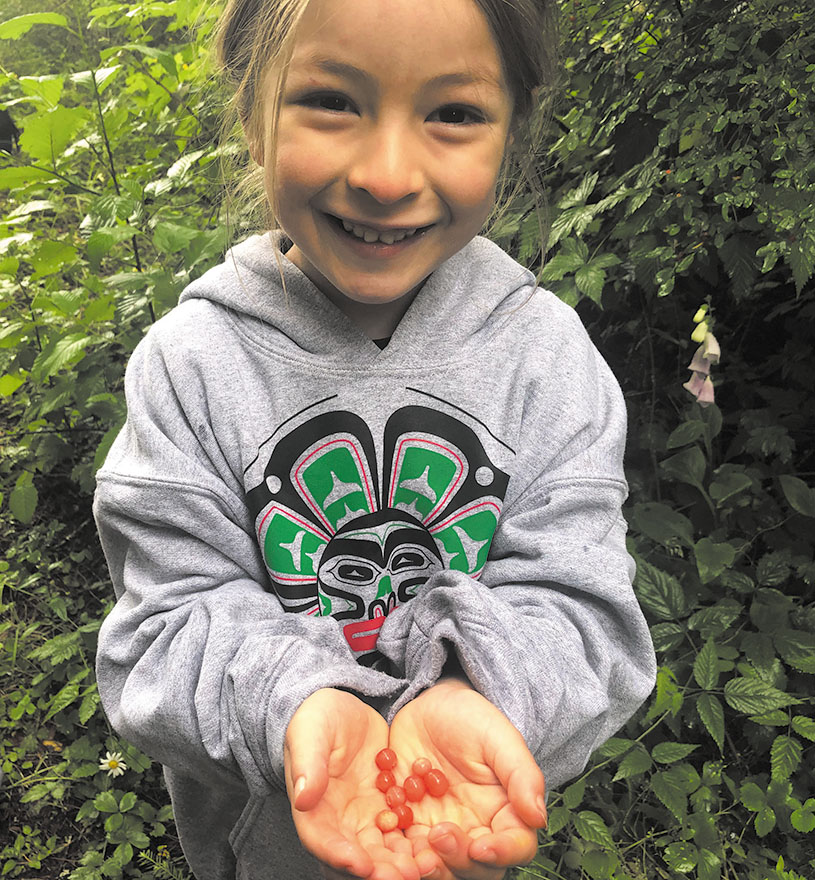
By Kalvin Valdillez, Tulalip News; photos by Natosha Gobin
“Doing this work has always meant a lot to me,” expressed Tulalip Lushootseed Language Warrior, Maria Martin. “I got to learn when I was at Montessori at a young age. Growing up, I committed myself to learning everything I could with the language; summer camp, anytime they had an event I could attend, I’d always check out the website. I took it on myself to be a part of it. And being able to share that now, it’s awesome because I have direct relatives that put in work to save the language. And it’s an honor to inherit that.”
The traditional language of the sduhubš is strong in modern day Tulalip and COVID-19 can’t do a thing about it. When Tribal government shut down daily operations to help flatten the curve and decrease the spread of the novel coronavirus, many people were glued to their smart phones, searching for updates about the disease, learning how to adequately protect themselves, and adapt to a more slow-paced, Zoom-led world.
During the very first week of the Tribal government closure, when the number of deaths by COVID-19 were spiking, good news was hard to come by. An evening scroll through the timeline was often accompanied by despair and a general fear for the health of you and yours. And then one day a slew of videos began to pop up and take over people’s newsfeeds.
“With everybody being forced to stay home, we still wanted to connect with our community so we had to get creative,” said Natosha Gobin, Language Instructor. “I knew that a lot of people were on social media, so we decided to throw some language out there. At such a time of unknown, here’s something positive, let’s take the opportunity to learn a couple words or hear a story together, connect with your kids, connect as a family. Most of the videos were geared to be just a couple minutes long. If a parent is scrolling through Facebook and their child is right next to them, then it’s as easy as ‘boom, let’s listen to this or let’s look at this real quick’. We really viewed it as a not only a way for us to stay connected with the community, but to reinforce that relationship with a parent and child learning together.”
Over the course of the school year, the Lushootseed language warriors develop a strong connection with their students as they are in the classrooms weekly, some teachers daily. When schools began to close, naturally the instructors began to miss their students, as well as preparing lesson plans and growing the minds of future Tulalip. When Lushootseed Program Manager, Michele Balagot, instructed her team to produce online language videos, they wasted no time. Videos of language warriors singing traditional Tulalip songs, sharing popular Salish stories and providing lessons in counting, colors, animals and shapes flooded the social media timelines of Tulalip families and citizens.
“That was new to us, we started with one person doing a video and then we built off of that,” explained Michele. “A week later we decided we needed to do some interaction, so the kids could practice and identify a shape or a color in the language. And then we started doing traditional stories, so the kids could still hear Lushootseed while they’re at home and be able to speak it, be interactive with it.”
A majority of the Lushootseed speakers work with younger children, thanks to a partnership with the Betty J. Taylor Early Learning Academy (TELA). The idea is that kids are more susceptible to pick up the language during the early childhood development stages. Out of a shared interest of providing Tulalip children with a strong cultural foundation and understanding, TELA developed the language immersion curriculum in which Lushootseed Warriors frequent the classrooms of the Early Head start and Montessori and pass on the language through fun activities, songs, and interactive stories.
“They [videos] were originally for TELA, but we posted the videos on Facebook and soon found out that the TELA kids weren’t the only ones watching,” Michele said. “We knew that kids of all ages were watching it because we kept getting all kinds of replies saying, ‘thank you my child sat down and watched it and was speaking the language along with the video.”
Maria, who mainly works with Quil Ceda Tulalip Elementary, has made a handful of videos for her students during the pandemic that inspired not only the parents who are at home learning with the kids, but also many of the QCT teachers.
“We went over greetings, feelings and their letter pronunciations, I tried sticking to the basics that the kids would know,” she stated. “I’m not sure how many of my students were able to watch it but I did see that it was being posted to the [QCT] Facebook page. I’ve been able to catch some of the parents in passing, and even some of the staff members, who have watched the videos and they really appreciate them and greet me in Lushootseed, so having that feedback is heartwarming for sure.”
Getting creative during the coronavirus outbreak, Natosha put a little extra pizzazz into her videos by incorporating other Indigenous lifeways into her lessons. For example, when participating in cultural activities as a family, such as harvesting berries, cedar or seafood, Natosha reached for her phone, hit record and watched the magic unfold.
“It’s natural for me to take my kids out with me and pass that knowledge onto them,” said Natosha. “We’ve harvested berries and harvested cedar, we also went out and harvested fireweed. A big part of what I’m teaching about is harvesting and making medicines. Involving my own kids was an important part for me because kids respond well to other kids learning. My daughter, Lizzy, she’s the one that I put on the spot the most. That’s because she’s the closest in age to those kids at TELA. She’s six years old, so it’s easy for me to say, ‘hey Lizzy, let’s record this, or let’s go for a walk and I’m going to ask you these questions.”
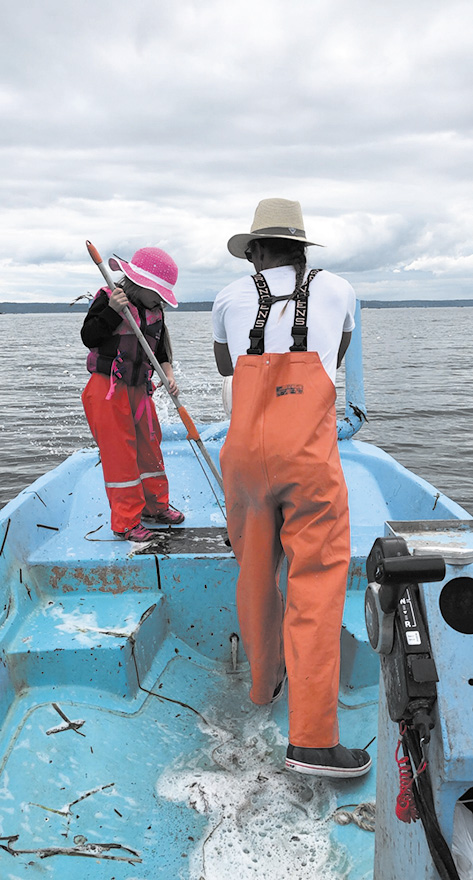
One visit to the Tulalip Lushootseed Facebook page and you’ll see a charismatic Tulalip youth effortlessly leading and narrating videos in the official language of her ancestors. Lizzy, her siblings, as well as the children of language warrior Michelle Myles, have unofficially become the new faces of the verb-based language and many tune-in weekly to catch their adventures with Lushootseed.
“She’s really taken on the role of teaching without fully understanding it. I’ve taken Lizzy out fishing and she did an entire fishing video. That video was probably the one that got the most attention, over 2,000 views. The viewers got to hear everything through her voice and it was repetitive so that you can easily learn from it. We want to take her out to dig clams and have her retell her great, great, great grandma Lizzy’s clam digging story, that’s one of the most popular stories that Lizzy Krise told. Lizzy Mae is actually named after Lizzy Krise. Grandma Lizzy is the one that we base a lot of our language after, we utilize everything that she passed on to us. She’s one of the people that we model a lot after, along with Martha Lamont. Lizzy will retell her grandma’s story through her own experience of clam digging for the first time. So, really just connecting it to what kids will respond to, what the kids will find interesting.”
In addition to the lessons for tribal youth and the students at TELA and QCT, the Language Warriors also teach a college-credit course for those looking to enhance their Lushootseed skills.
“We normally have community college classes this time of year, but with COVID we can’t do those,” expressed Michele. “So Natosha Gobin, Michelle Myles and I started an online Intro to Lushootseed class through Zoom. We had sixty-four participants and it was a seven-week course. We had Tribal members, other Natives, students from previous years, teachers, a good mix of everybody.”
We are currently living in an era where the Lushootseed language revitalization revolution is in full effect. And just like in previous eras, such as forced assimilation, the Tulalips are taking it upon themselves to ensure the language and the culture prevails long past the present threat of the global COVID pandemic.
“We hope that our community can look at these videos that we create and the online learning opportunity as a means for them to learn at their own pace during these difficult times,” said Natosha. “I think that’s probably the biggest thing, we want to reach our community by whatever means necessary. We’ll provide the tools, we just really want to encourage our community to utilize them.”
“At first, I thought nobody’s going to watch this, because people are at home and COVID is happening,” admits Michele. “But then everybody started sending in messages asking if we can do certain lessons or stories because a lot of parents are doing the homeschool thing. We have people telling us that when they go out, their child is naming the colors and shapes they see, and they are singing our songs. It’s important for the kids to learn their language. If you don’t keep hearing it and keep speaking it, then you forget it. By having these videos available, it keeps it fresh in the kid’s mind.”
For more information, please visit the Tulalip Lushootseed Facebook page or contact (360) 716-4499.
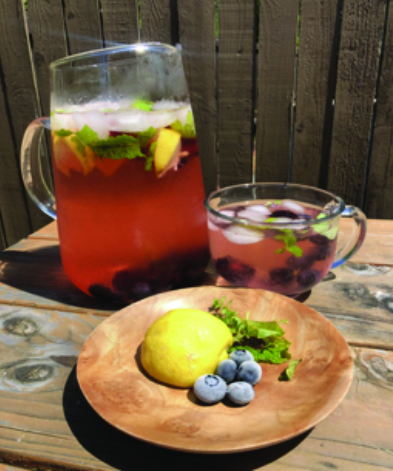
Submitted by Tulalip Tribes SNAP-Ed Coordinator, AnneCherise Jensen
Did you know that water makes up nearly half of your body weight? Naturally, the human body loses water each day when you sweat, go to the bathroom, and complete simple, everyday tasks. The more active you are, the more water you lose. And when the temperatures are really hot, you tend to lose water even faster. That is why proper hydration is extremely important to your overall health, especially during the summer.
The human body requires water for survival – every cell, organ and tissue needs water to function properly. Water helps eliminate toxins and unwanted bio waste lingering in the organs. Water also helps regulate the digestive system, lubricate the joints, regulate blood sugar, lowers body temperature when needed, maintains electrolyte balance and boosts overall energy. Water is our friend, and proper hydration can help you reach many of your health and wellness goals. Here are some tips and tricks to help keep you hydrated this summer!
Calculating Your Hydration Needs:
The CDC recommends the average person drink at least 8 cups ( ½ gallon ) of water per day. However, some individuals may require more fluid needs than others. Typically, men require more fluids than women – generally, the more you weigh, the more fluids you will need. Individuals who spend a lot of time in hot weather or those acquiring more than 30 minutes of exercise per day will be at a higher risk for dehydration, requiring more fluid intakes. Individuals who are sick or have chronic medical conditions may also require more fluids. As a general rule of thumb, use this simple calculation to estimate how many cups of water you should probably be drinking a day:
Weight in Pounds x .66 = ___ ounces of fluid / divided by 8 *Note there are 8 ounces in a cup so divide the total number of ounces by 8 to convert ounces to cups.
Example 1: 160 lbs. x .66 = 105.6 ounces /8 = 13.2 cups of water a day
Example 2: 210 lbs. x .66 = 138.6 ounces /8 = 17.32 cups of water a day
Note – you should try to add 12 ounces of water to your daily total for every 30 minutes of strenuous physical activity. So if you work out for 60 minutes daily, you would add 24 ounces (or 3 cups) of water to your total daily intake.
Dehydration Warning Signs:
When dehydrated, bodily functions can be negatively impacted. Ultimately, the best way to avoid dehydration is to avoid it before it happens. However, in case you or someone you know becomes dehydrated, it’s important to be aware of some of the early warning signs. In doing so, you can begin to replenish your fluid levels before more dangerous symptoms occur, such as heat stroke. Here are some of the following warning signs of dehydration you should know:
Thirst, dark urine, headache, little to no urine loss, flushed skin, increased body temperature, dizziness, increased weakness, vomiting, fainting.
8 Helpful tips to help keep you hydrated this summer:
Eat foods high in water content. Most fruits and vegetables have high water contents and help fuel us with water, vitamins and minerals needed for good health. Some foods with high water content include watermelon, cantaloupe, oranges, lettuce, spinach, celery, carrots, strawberries, grapefruit, bell peppers, apples as well as soups and broths. Choose a variety healthy beverages. 100% fruit and vegetables juices that are low in sugar content are a great option. Milk choices like low fat regular milk, yogurts, soy, oat and almond milk help hydrate too. Another great option includes herbal iced teas, that offer a unique and earthy flavor. When choosing healthy beverages, try sticking to choices that are low in sugar content. For active individuals, sports drinks that contain electrolytes are a great option too!
Invest in a reusable water bottle. Invest in a durable, temperature controlled water bottle. Keep this with you throughout the day and make a habit to drink from it as often as possible. Not only will you be staying hydrated, but you will also help limit the use of plastic water bottles, in turn helping the environment.
Try infused water. One of my personal favorite summer beverages is infused waters. Plain water can get dull, so try adding frozen berries, lemon, limes, cucumbers and fresh herbs to liven up your water.
Drink water when hungry. Thirst is often confused with hunger, so when you’re feeling hungry, try drinking water instead. Doing so, may also contribute to a healthy weight-loss plan. Some research suggests that drinking water can help you feel more full throughout the day.
Develop a healthy hydration routine. For many of us, drinking water can be a chore. We often forget to drink water alongside our busy schedules. If that’s the case, try creating a hydration routine, setting specific times in the day you dedicate to hydrating yourself. For example, drink water when you wake up and at the beginning or end of every meal. Or try drinking a small glass of water at the beginning of every hour.
Drink water at restaurants. For those who are choosing to eat-out at this time, remember to drink the water that’s served, it’s free!
Find a hydration buddy. Time goes by fast, and it’s easy to forget drinking liquids. Find a friend or family member who wants to reap the health benefits of being properly hydrated. Team up, remind each other, and keep one another accountable!
Healthy Recipe: Berry + Herb Water Infusion
Ingredients
Directions
**This material was funded by USDA’s Supplemental Nutrition Assistance Program – SNAP. This institution is an equal opportunity provider.
Source: https://www.eatright.org/fitness/sports-and-performance/hydrate-right/hydrate-right
https://goodcalculators.com/water-intake-calculator/
https://www.cdc.gov/healthywater/drinking/nutrition/index.html
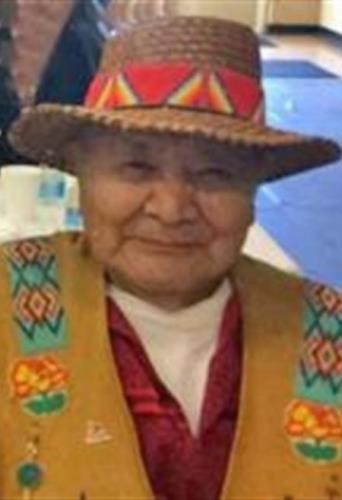
HUMBLE ARMY VETERAN PASSED AWAY JULY 12TH, 2020 WITH HIS FAMILY BY HIS SIDE AND MANY PRAYING FROM AFAR FOR A GREAT WARRIOR “UNCLE NEIL”
HE WAS BORN AUGUST 4, 1933 TO HIS LOVING PARENTS ALBERT AND ANNIE MOSES OF SNOQUALMIE WASHINGTON. RAISED WITH 13 SIBLINGS AND MANY FRIENDS AND FAMILY. A TULALIP TRIBAL MEMBER WERE HE LIVED HIS LONG LIFE.
HE BEGAN HIS JOURNEY WITH HIS LOVING MOSES FAMILY. COMING FROM A LARGE FAMILY WITH GREAT TEACHINGS AND BEAUTIFUL CULTURE. HARD WORK AND DEDICATION CAME EARLY, .AFTER SCHOOL HE SIGNED UP FOR THE NATIONAL GUARD. SOON AFTER HE INLISTED IN ARMY 1952 WERE DROVE HIGHER RANKED OFFICERS. THIS SKILL LASTED A LIFE TIME DRIVING THE MOST IMPORTANT PEOPLE IN HIS LIFE. WERE HIS TREASURED MEMORIES WILL FOEVER LAST IN OUR HEARTS.
LATER BEING DISCHARGED FROM THE ARMY. HE CAME HOME TO WORK AS A LOGGER, CUTTING SHAKE BOARDS. EVERY GREAT STORY HE TOLD ALWAYS INVOLVED FAMILY, FISHING AND MOUNTAIN LIFE. HIS LOVE FOR THE MOUTAINS GREW WHEN HE MET MARYA JONES MOSES HIS LIFE PARTNER OF 53 YEARS. THIS SKILL OF DRIVING CAME AS AN ART AND DEFINETLY WAS HIS BEST TRIBUTE AS ONE OF THE BEST FISHERMAN. HIS LOVE FOR THE WATER SHOWED. WERE THEY WERE THE GREATEST FISHERMAN. IT PUT TULALIP BAY ON THE MAP. PAVING WAY, OF COMMERCIAL FISHING AND SUPPORTING MARYA IN EVERY ADVENTURE. BEING A ELITE FISHERMAN WITH HIS CREW-CHILDREN BY HIS SIDE MAKING THE MOST HISTORICAL DAYS IN TULALIP BAY. HARD LABOR THROUGHOUT THE COMMUNITY CUTTING THE TREE DOWN THAT BUILT THE CANOES. CO-CAPTAIN AND DRIVING MARYA WAS SUCH A PASSION FOR HIM. TRAVELING AND BEING A GREAT SUPPORT TO THEIR COMMUNITY. THEIR INVOLVEMENT WITH COMMUNITY HELPED PRESERVE AND REJOICE IN OUR CULTURE. NEIL AND HIS BROTHERS HUMBLY PARTICIPATION IN SALMON CERMONIES. FINE TUNNING THERE DRUMS WITH BEAUTIFUL VOICE THE LEADING MEN AND WOMAN, TEACHING FAMILY’S FROM THE COMMUNITY. MARYA AND NEIL NEVER MISSED A FUNERAL WITH HIS GLORIOUS PRAYER SONG THAT INBEDDED INOUR HEARTS FOREVER. HE NEVER LET THAT BLESSING SONG GROW OLD, FOR IT COMFORTED HIS PEOPLE. BEING CO-CAPTAIN FOR MARYA WAS TRULY AMAZING. MARYA’S TIME WITH NEIL CAPTURED AND BUILT A GREAT FAMILY. RESPONSIBILITY WAS JUST ONE PIECE OF HIS GREATNESS. HOW HE CONNECTED WITH MARYA’S CHILDREN LEFT A BLESSING FOR THE WHOLE FAMILY. HE WAS A SMOKE HOUSE DANCER AND HIS BEST TIMES WAS WITH HIS BROTHERS AND KENNY MOSES SR SITTING AROUND A FIRE. PROUD TO BE A VETERAN HIS LONG TIME FRIENDSHIP WITH ALL PRESENT AND PAST MEMBERS OF TULALIP HONOR GUARD WILL NEVER BE FORGOTTEN. ANOTHER TRIBUTE HE SHARED WITH MARYA BEING A GOLD STAR MOTHER BY HIS SIDE.
HE WAS A ANCHOR FOR HIS FAMILY “ANGELS” ALWAYS SUPPORTING FINANCIALY NEVER ASKING MUCH FROM THEM BUT TO STAY HAPPY. HIS SMILE ALWAYS SHOWED HOW PROUD HE WAS OF HIS LOVED ONES.
HIS HONEST HUMBLE QUALITY WILL BE MISSED YET NEVER FORGOTTEN. HIS CARE GIVERS AND FAMILY THAT SHARED HIS LIFE, WILL ALWAYS REFLECT ALL THOSE SHINING QUALITIES. FOR THIS BLESSING IS OUR BLESSING. HIS NEPHEWS/GRANDSONS “PALS”. FAVORITE NIECE/GRAND DAUGHTER ANNA MOSES, HE ALWAYS SO PROUD OF NAME SHE CARRIES SO WELL. HE SHARED THE MOST WONDERFUL GUDIANCE AND LAUGHS WITH SOPHIA AND GOOD MEALS. MARYA AND HIS FRIENDSHIP WITH FATHER PATRICK TWOHY AND THE LATE SISTER BARBARA BEIKER KEPT US CLOSE AS FAMILY. TEACHING US PATEINCE ANOTHER STRONG QUALITY HE LEFT US TO LEARN AND GROW FROM. TERESA ALL THE GRANNY STORE VISITS AND REMEBERING BIRTHDAYS, TRAVELING AND CARING FOR HIM DAILY, HE WAS ALWAYS SO GREATFUL TIQ.WSEED
BELOVED BY FAMILY, CHILDREN, NUMEROUS NIECES, NEPHEWS AND FRIENDS. AS HIS JOURNEY STARTS AS HE TRAVELS AHEAD OF SISTER IRENE (WILSON) DANIELS. HE LOVED EVERY MOMENT SHARED WITH “IRENE MY SISTER” FAMILY-CHILDREN JOHANNA MOSES, GILBERT (JANICE) MOSES SR., APRIL (MARVIN) SMITH, RACHEL HOOD, JULIE (DARWIN) RUSSELL, VICKIE (GEORGE) TSOODLE, TERESA WHITISH AND DANIEL (LEANNA) MOSES SR.
ELDER- STRENGTH THAT GROWS WITH WISE HUMLE LOVE, EVERY BIT NEIL. HE ALWAYS SEEN EVERY DAY AS A GOOD DAY. BEGINNING WITH PRAYER AND TELLING AND SHARING WITH LOVED ONES. HIS ANCESTORAL COMPASSION WAS ANOTHER GREAT QUALITY WICH HE CARED AND WAS PROUD OF ALL HE PROCEEDED: FATHER AND MOTHER ALBERT AND ANNIE MOSES. BROTHERS:GEORGE MOSES,CLARENCE MOSES,MATTHEW MOSES,DELBERT MOSES,ROBERT MOSES SR, MORGAN MOSES,LOUIE MOSES,ALVIN MOSES SR.,EARL MOSES,FLOYD MOSES SISTERS: BARBARA MOSES AND BABY LUCINDA MOSES
A graveside service will be held Friday, July 17, 2020 at 11:00 AM at Mission Beach Cemetery. August 4, 1933 – July 12, 2020

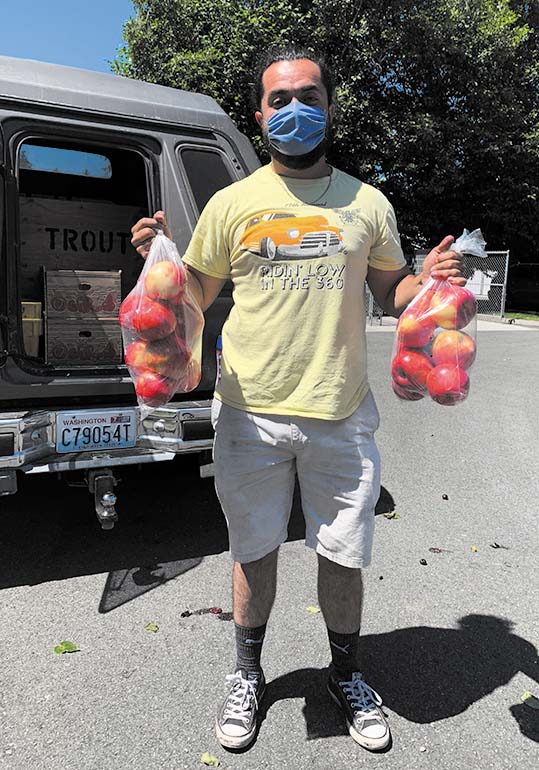
By Kalvin Valdillez, Tulalip News
“Can I get one bag of apples, two bags of cherries, and if you still have them, some apricots too?” inquired a local man of the Maryville-Tulalip area.
Simply nodding yes, Hugo Sanchez-Garcia began to scoop plump, ripe cherries into paper bags while making friendly conversation with the customer as he fulfilled his request.
“Will $60 work?” the man asked.
“Yes, absolutely. Thank you,” Hugo graciously replied as he handed him his order.
Only two short orders behind this gentleman, a lady ordered nearly double his order, three bags of apples, four bags of cherries and two punnets of apricots.
“I have a big family,” the woman said while offering a smile that was ever-so-slightly visible underneath her mask. “This will all be gone by tomorrow.”
This time, however, when the currency-produce exchange occurred, the lady stated she only had $12.
“That’s perfect,” Hugo said sincerely and kindly. “Thank you.”

Nobody was prepared for the curveball that the year 2020 had in store for us. The presence of COVID-19 has caused many people to reevaluate their lives in terms of health concerns and also their line of work, as businesses are beginning to lay off employees nationally, and in some cases permanently close altogether.
Hugo found himself in a predicament that many Americans are currently facing; continue searching for employment in his most recent line of work, or start anew. Hugo chose to pivot.
“After COVID hit, it was kind of hard for me to find a job doing what I was doing before,” Hugo explained. “And my dad has been kind of nagging me for a while to bring fresh produce here because there’s a lot of fruit in Chelan, which is where we grew up. So I thought, let’s give this a shot and see how it goes.”
Filling up his pickup truck with freshly picked fruit from orchards at Chelan, Hugo becomes his alter-ego, better known as the Apple Guy, when making weekly deliveries all through Western Washington. Originally, the Apple Guy was taking online orders and making home deliveries. That is until he got in contact with Tulalip tribal member, Natosha Gobin, who helped him establish a base at the parking lot of the Tulalip Market.
“He has different stops up and down I-5,” Natosha said. “He sets up shop and sells bags of apples on a sliding scale – $5, $10, free. If you show up and you say you don’t have the means to buy apples, but you would love a bag, he’ll give you a bag of apples. He’s also done some pretty big donations to our community. He’s donated apples to me knowing that I know a lot of people in Tulalip, so we put those apples on the doorsteps of some of the elders and the seniors.”
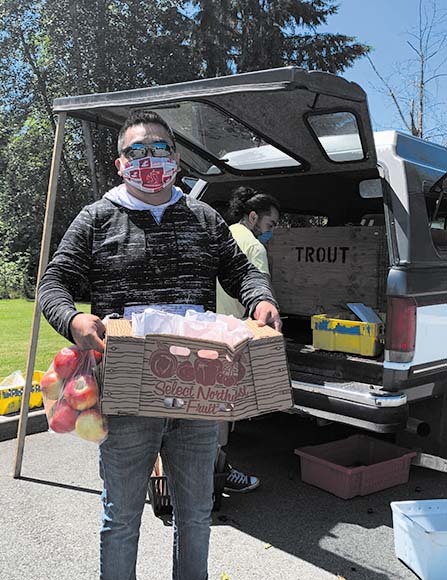
With Natosha’s assistance and rave reviews all over Facebook, word about the Apple Guy’s produce delivery service has the town buzzing.
“My wife, she’s always on Facebook so she tells me when he’s around and what he’s got,” said Tribal member Kurtis Enick. “He posts every week, which is a great for my family. When I go home with this, I know that they’re going to be so happy with me, because my daughter is just now starting to get her teeth and she loves eating apples. My wife likes the apricots and the cherries, and my son is a vegetarian and only eats fresh produce.
“It feels really good knowing everything is local, everything is coming from Chelan or somewhere in Washington,” Kurtis continued. “It feels really good to taste that fresh-off-the tree fruit, that good stuff. And it’s a whole lot better than going to the store and looking through all the fruit that they say is fresh but it’s not really that fresh, nowhere near as fresh as this.”
Although it is important for Hugo to profit off of these deliveries to cover costs as well as living expenses, money is not his main objective. In fact, currency is sort of a miniscule aspect to this project compared to the reason he decided to ‘give it a shot’.
“I do operate on a sliding scale,” he said. “There are two guiding principles that I set when I first started out. One of them being that access to food is a human right. The second one is that we’re all occupants on Tribal lands, so it’s important that we move as guests, it’s our responsibility.
“I think it’s also important to recognize that fresh food isn’t as easily accessible on certain reservations. I think a lot of people, and especially a lot of communities of color, don’t have access to a lot of fresh fruits. So, what is the point of bringing it all the way out here if folks couldn’t afford it? I think ultimately every individual knows what they can and can’t afford. So, I trust their judgment to pay what they can.”
Hugo is currently selling a variety of apples including Honeycrisp, Fuji, Gala, and Granny Smith. His selection of cherries right now are Rainier, Bing, Sweetheart and Lapin. Hugo also has apricots and will have peaches in the near future.
Be sure to follow The Apple Guy on Facebook for his complete list of produce for sale as well as his weekly scheduled stops.
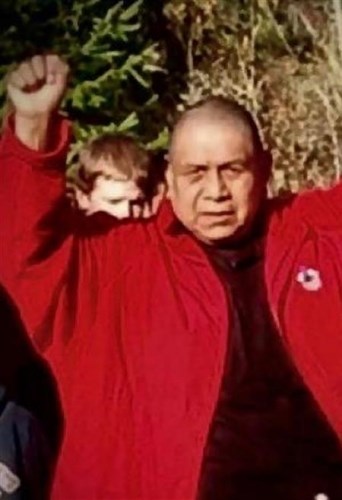
Duane C. Ike Sr, 75 of Tulalip, WA, went home to Glory July 6, 2020 in the comfort of his home.
He was born Feb. 11, 1947 in Chehalis, WA to Howard and Sally (Purcell) Ike. He was raised and educated in Toledo, WA.
He was a member of the Yakama Nation. He started working at the age of 14. He worked for various logging companies Tiin – ma; Wheelers; Mistletoe; and Yakima Forest Products. He retired at the age of 63. He enjoyed family gatherings; fishing; hunting; wood whittling; reading; coaching sports; his grandchildren; and most of all studying the Word (Bible). He was a member of the Tulalip Worship Center.
He is survived by his wife Francine Ike; children, Lucille Ike, Sally Armour, Georgia Ike-Taylor, Francis Ike, Lois Ike, Duane Ike Jr., Louis Ike, Trisahna Ike, Travis Vanfelt Wasco, Billy James, Darrin Howard, Gilbert Andrews, Ron Iukes, Billy Herrera, and Jake Britton; and his sister, Lila Loggins. He was preceded in death by his parents; daughter Rosalind Ike; son-in-law Kelly Joe Strong Sr; brothers, Matthew Ike Sr. and Ted Satanus; sisters Alice Ike, Charlette Wahpat and Helen Smartlowit.
Graveside services will be held Tuesday, July 14, 2020 at 12:00 Noon at Mission Beach Cemetery. February 11, 1947 – July 6, 2020
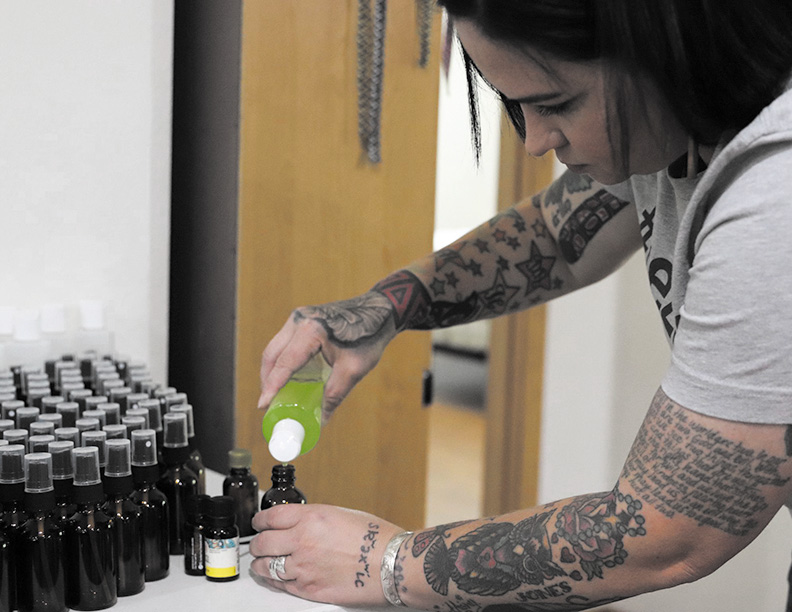
By Kalvin Valdillez, Tulalip News
As many will recall, when the elusive coronavirus first struck the U.S., panic ran rampant throughout the nation. Perhaps in anticipation of self-quarantine or lockdown, people rushed to the supermarket to stock up on their essentials needs. Although this particular moment will go down in history as the great toilet paper shortage of 2020, TP wasn’t the only shelf left empty by panicked consumers. In fact, most home cleaning supplies were also completely sold out including disinfectant wipes and spray, paper towels, multi-purpose sprays and hand sanitizer.
“There were a lot of call outs on Facebook from people in the community, especially elders, saying they had no sanitizer, no masks or gloves,” explains Tulalip tribal member Sarah Hart. “I immediately went to the store thinking, I’ll just go pick up a bunch of hand sanitizers, I don’t mind paying for it. And then I got there, there was literally nothing. That’s when I knew I had to make something happen.”
Solely out of concern for her fellow Tulalip community members, Sarah began to brainstorm ways to keep her loved ones as safe as possible during the pandemic, ultimately deciding to dedicate her stay-at-home hours to producing hand sanitizer.
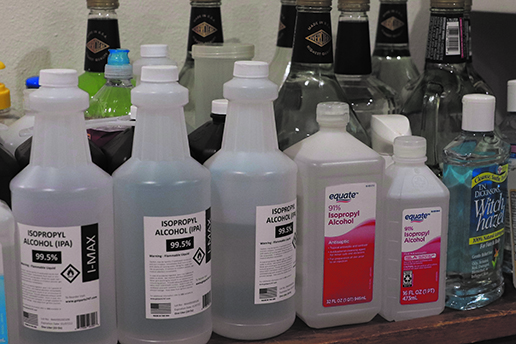
“For two days straight I YouTubed videos on how to make your own sanitizer and went on the CDC website to make sure it was strong enough. I felt the need to do something for the community because a lot of people didn’t have any hand sanitizer. I figured I could make a few bottles for when people go out to the store and they touch something like the carts, at least they could have one of my bottles on-hand and it could potentially save their life.”
While organizations such as the CDC (Centers of Disease Control), FDA (Food and Drug Administration, and WHO (World Health Organization) maintain that washing your hands with warm soapy water for at least twenty seconds is key in limiting the spread of COVID, they also state that an alcohol-based hand sanitizer will be effective in a pinch or on-the-go until you are able to properly cleanse your palms and digits.
Sarah wasn’t the only person manufacturing hand sanitizer out of the comfort of her own home, in fact several DIY hand sanitizer step-by-step guides were released during the early months of COVID. Around the world people were making sanitizer with the intention of personal use or financial gain. Unfortunately for many, due to cutting corners for profit or not using the proper ingredients, their homemade hand sanitizers were either rendered ineffective or caused unpleasant side effects such as burns and rashes.
This was something Sarah intentionally avoided from the start, claiming that cheaper products would not come at the expense of her people’s health. So when the CDC recommended an alcohol base of at least 60%, Sarah went out and purchased 190-proof Everclear, 30% stronger than the CDC recommendation, essentially telling COVID that she is not messing around.
“It took me a good two weeks to get the consistency that I felt was safe enough. When I make a batch of one-hundred bottles I use Everclear, aloe vera, hydrogen peroxide, witch hazel for the skin so it doesn’t dry out and tea tree oil. If you go on Etsy or anywhere online 90% of the people that make it cut it with distilled water or rose water, something to make it cheaper.”
Once she had her recipe down, she recruited her youngins to lend a hand and assist with creating the concoction as well as bottling and distributing the product. Eventually over time, their passion for the family hand sanitizer project grew perhaps even larger than Sarah’s.
“My kids have been amazing,” she expressed. “It makes me happy that my little ones are into helping. For the first two months we were making it every day and every morning they would wake up and were like, ‘let’s make hand sanitizer!’ They’ve helped tremendously.
“It has turned into something bigger than I thought it would be. For two months, I delivered hundreds and hundreds of bottles. And now, a few days out of the week I’ll make a batch of a hundred bottles and put them at the end of my driveway on a table and tell people to be safe and come and grab how many ever they need. And when I put them out, I spray them down all down, just in case because what if I’ve been in contact and unknowningly pass it to an elder or someone in the community.”
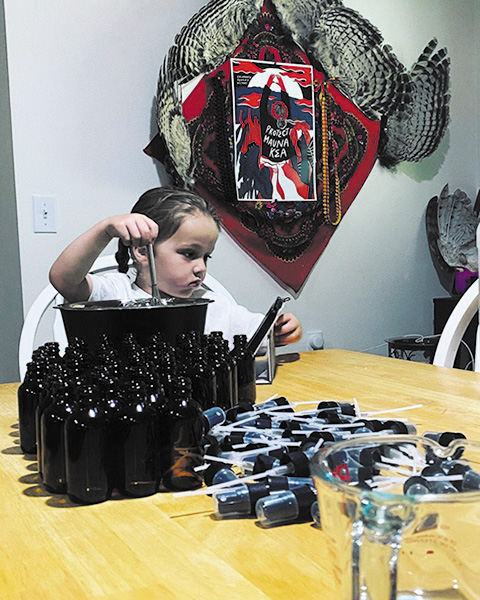
In addition to delivering the hand sanitizer, on two separate occasions Sarah and her kids assembled care packages for the elders of Tulalip by pairing two masks, two pairs of gloves and two hand sanitizers in Ziploc bags, on which they included a personal drawing or message for the recipients. Those care packages in turn inspired Sarah to help out a fellow Indigenous nation who have been hit hard by the pandemic, sending 200 care packages filled with masks and sanitizer to the Navajo Nation. You can also spot the employees of the Marysville Safeway, Albertsons, and local coffee stands utilizing Sarah’s sanitizer as she drops off dozens of bottles to local businesses during her weekly delivery rounds.
High quality product requires a big budget and typically generates enough revenue for additional production costs as well as labor. Sarah’s main objective, however, is ensuring her people have the necessary supplies to protect themselves against corona and she has no intention of charging for her sanitizer. After emptying her entire savings account, she began to look at different possibilities and ways to obtain funds in order to continue her project.
After organizing a 50/50 raffle and receiving friendly donations here and there, she was able to purchase more supplies. But with COVID not going anywhere anytime soon, she found the demand to be surprisingly higher than she originally expected. For this reason, she took the advice of fellow Tribal member, Natosha Gobin.
“She’s doing amazing work,” says Natosha. “Making hand sanitizer can be really pricey, so I set up an Amazon wish list for her and have been encouraging the community to go on there and purchase and send her materials. To see somebody take the initiative and say, I’m going to learn how to make this, I’m going to put my money into it and I’m not going to burden people with the cost, that shows a lot of heart. She didn’t want anything in return. The recognition wasn’t even something she was searching for, it’s just that desire to serve our community. It’s just in our DNA to take care of each other. It’s a perfect example of what our community is.”
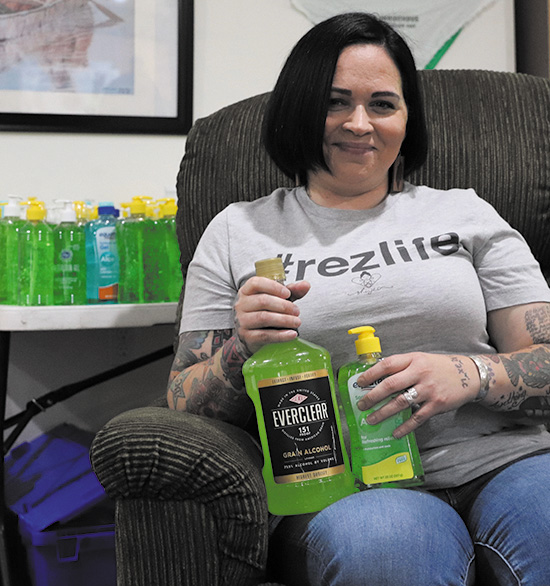
“My main focus with everything is our people,” Sarah states. “Especially at the beginning of the pandemic, making sure they had something because there was so much going on. The smiles on their face makes it all worth it for me. I’ve definitely had my emotional moments; I love my people and community. This is more than sanitizer, this could help save a life and it’s made with so much love in it. I also started making alcohol wipes to hand out, for people to use and keep in their cars. With the numbers growing I feel it’s only necessary to do anything I can to help protect our people.”
To make a donation to Sarah’s hand sanitizer project, please contact her directly via Facebook or visit her Amazon wish list to help purchase supplies at https://www.amazon.com/hz/wishlist/ls/1GIIUU6SBIAV5?type=wishlist

Please use the following link to download the July 11, 2020 issue of the syəcəb
